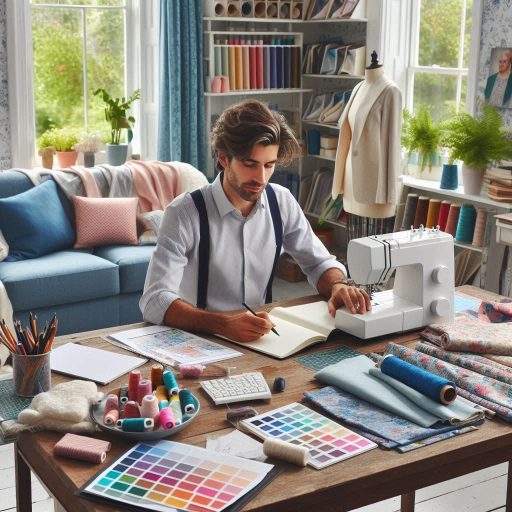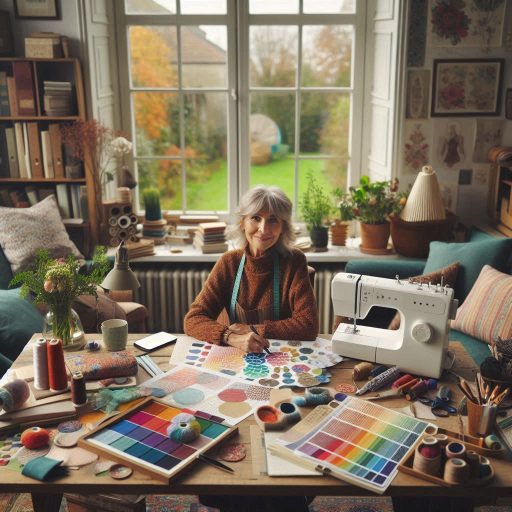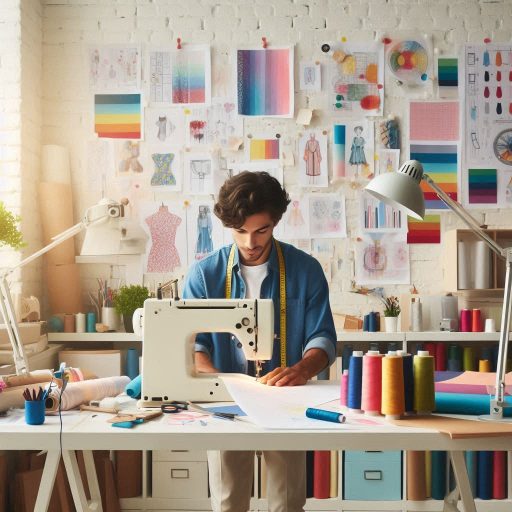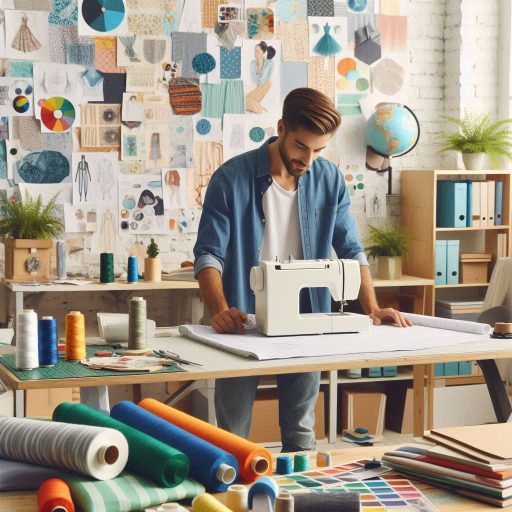Introduction
Collaboration in the design industry is crucial for success.
As the field evolves, the complexity of projects often requires diverse skills and perspectives.
Working with other designers fosters creativity and innovation, allowing teams to tackle challenges more effectively.
The synergy created through collaboration can lead to extraordinary solutions that might not emerge from individual efforts alone.
The benefits of collaborating extend beyond just creativity.
Designers can share knowledge and enhance their skills by learning from one another.
This exchange of ideas enriches their toolkits and helps them stay current with industry trends and techniques.
Collaboration also nurtures strong professional networks, creating lasting relationships that can lead to future opportunities.
In this post, we will explore key strategies for successful collaboration.
First, we will discuss the importance of establishing clear communication.
Next, we will cover how to set common goals and align visions among team members.
Embracing feedback is another critical aspect we will address, as it allows for growth and improvement.
Lastly, we will highlight the importance of respecting each other’s styles and processes.
By understanding these elements, designers can maximize their collaborative efforts and achieve remarkable results together.
Establish clear goals and expectations
Collaborating with other designers can be a rewarding experience, but it requires careful planning and communication to be successful.
One of the first steps in collaborating with other designers is to establish clear goals and expectations for the project.
This ensures that everyone is on the same page and working towards a common goal.
The Purpose of the Collaboration
Before embarking on any collaborative project, it is crucial to clearly define the purpose of the collaboration.
Ask yourself: What are we trying to achieve together.
Are we creating a new product, solving a design challenge, or brainstorming innovative ideas.
Defining the purpose will serve as the guiding star for the project, helping to align everyone’s efforts toward a common vision.
It ensures that all participants understand the significance of their contributions and how they fit into the larger picture.
This shared understanding fosters a sense of ownership and accountability among team members, leading to more engaged and motivated collaborators.
Set Clear Objectives and Desired Outcomes
After establishing the collaboration’s purpose, the next step is to set clear objectives and desired outcomes for the project.
It‘s essential to articulate what you hope to achieve through this partnership.
Specific goals provide a roadmap for the collaboration and create measurable benchmarks for success.
Identify desired outcomes like increased creativity, improved problem-solving, or timely project delivery.
Track progress and celebrate milestones along the way.
Clear objectives also help to focus discussions and decisions, ensuring that everyone remains on track and contributes to achieving the overarching goals.
Roles and Responsibilities of Each Designer
For any collaboration to be effective, it is vital to discuss and clarify the roles and responsibilities of each designer involved in the project.
Clearly defining who is responsible for specific tasks and deliverables helps to prevent misunderstandings and ensures that everyone knows what is expected of them.
This clarity not only enhances individual accountability but also promotes teamwork, as each member understands how their work impacts the overall project.
Moreover, discussing roles allows the team to utilize each person’s strengths effectively, ensuring that tasks are allocated based on skill sets and expertise.
An equitable distribution of workload fosters a collaborative environment where everyone feels valued and engaged.
Establishing Communication Channels
Effective communication is the lifeblood of any collaborative effort.
Once roles and responsibilities are defined, it is essential to establish open lines of communication among team members.
Regular check-ins, progress updates, and feedback sessions are crucial to keeping everyone informed and aligned.
Encourage a culture of openness where team members feel comfortable sharing their ideas, concerns, and suggestions.
Utilizing collaboration tools and platforms can facilitate seamless communication.
Ensuring that all participants stay connected and engaged throughout the project lifecycle.
By establishing clear goals and expectations from the outset, you can lay a solid foundation for a successful collaboration with other designers.
Define the purpose clearly. Set specific objectives to guide the team.
Discuss roles and responsibilities for each member.
Maintain open communication to ensure everyone works toward a common goal.
With a collaborative mindset in place, your team can navigate challenges effectively, resulting in a completed project that meets or exceeds expectations.
Ultimately, a successful collaboration not only achieves its objectives but also cultivates lasting relationships and fosters a culture of creativity and innovation.
Read: Top Skills Needed for Art Educators and Instructors
Communicate Effectively
Effective communication is vital for successful collaboration among designers.
It ensures everyone is on the same page and promotes a healthy working environment.
Here are key strategies to enhance communication:
Maintain Open and Transparent Communication
- Encourage Honest Dialogue: Foster a culture of honesty where team members feel safe sharing ideas and feedback.
- Share Project Goals: Clearly outline project objectives from the start.
This helps everyone understand their roles and contributions. - Regular Check-Ins: Schedule regular meetings to discuss progress, challenges, and updates.
Consistent check-ins keep the team aligned. - Use Collaborative Tools: Utilize project management tools like Trello or Asana.
These platforms centralize information and improve visibility. - Create a Feedback Loop: Establish a process for giving and receiving feedback.
Encourage team members to share constructive criticism.
Preferences for Communication Channels
- Identify Preferred Tools: Discuss and agree on preferred communication platforms, such as Slack, email, or video calls.
This streamlines interactions. - Adapt to Team Needs: Consider individual preferences for communication.
Some may prefer instant messaging, while others like emails for detailed discussions. - Set Communication Norms: Establish guidelines for response times and availability.
This sets clear expectations and reduces frustration. - Encourage Active Participation: Foster an environment where everyone feels encouraged to contribute during discussions.
This ensures diverse perspectives.
Address Any Misunderstandings Promptly
- Acknowledge Miscommunications: Recognize when misunderstandings occur.
Addressing them quickly prevents small issues from escalating. - Clarify Intentions: When misunderstandings arise, clarify your intent.
This helps realign the team‘s focus and minimizes confusion. - Use Empathy in Discussions: Approach conflicts with empathy and understanding.
This encourages a supportive atmosphere and fosters positive resolutions. - Reiterate Key Points: Summarize important discussions to ensure clarity.
This reinforces understanding and keeps everyone informed. - Seek Feedback on Communication: Regularly ask team members for feedback on communication methods.
Continuous improvement leads to better collaboration.
By implementing these strategies, you can foster a collaborative environment that thrives on effective communication.
Open dialogue, clear preferences, and prompt resolution of misunderstandings create a strong foundation for teamwork.
Embrace these practices to enhance collaboration and achieve successful design outcomes.
Read: Collaborating with Other Creative Roles
Respect Each Other’s Expertise
Acknowledge and appreciate each designer’s skills and knowledge
Successful collaboration among designers hinges on mutual respect for each other’s expertise.
Acknowledge and appreciate each designer’s unique skills and knowledge.
Each team member brings different experiences and perspectives to the table.
Recognizing these differences fosters a positive environment for collaboration.
Encourage sharing of ideas and feedback
Encourage sharing of ideas and feedback throughout the design process.
Open communication helps uncover innovative solutions.
Create a safe space where everyone feels comfortable voicing their thoughts.
Allow each designer to express their creativity without fear of judgment.
Emphasize the importance of collaboration over competition within the team.
Be open to constructive criticism and suggestions
Be open to constructive criticism and suggestions.
Accepting feedback is crucial for personal and professional growth.
Approach feedback with an open mind, focusing on improvement rather than defensiveness.
Encourage team members to provide specific examples when offering suggestions.
This clarity helps ensure that everyone understands the context and intent behind the feedback.
Implement regular brainstorming sessions to promote idea sharing.
Set aside dedicated time for collaborative discussions.
Use these sessions to explore new concepts and refine existing ideas.
Invite all designers to contribute, ensuring diverse perspectives inform the process.
By valuing each person’s input, the team can develop more robust and creative solutions.
Establish guidelines for giving and receiving feedback.
Encourage a culture where feedback is constructive and actionable.
Use positive language to frame critiques, which helps maintain morale.
Focus on the work rather than the individual when discussing areas for improvement.
This approach fosters a supportive environment that nurtures creativity.
Facilitate mentorship opportunities within the team.
Pair experienced designers with newer team members to promote knowledge sharing.
This collaboration enhances skills while building relationships and trust.
Encourage both parties to learn from each other, creating a dynamic learning environment.
Respecting each other’s expertise is vital for successful collaboration among designers.
Acknowledge individual skills, encourage open communication, and welcome constructive criticism.
By fostering an environment of mutual respect, teams can unlock their full creative potential.
Ultimately, this respect will lead to innovative designs and successful outcomes.
Read: Historic Costume Design Inspirations

Create a Collaborative Workflow
A successful collaborative workflow enhances teamwork among designers.
It streamlines the project process, ensuring everyone stays on track.
Here are some key steps to establish an effective workflow.
Establish a Timeline and Deadlines
Start by defining a clear timeline for your project.
Break the project into manageable phases and set deadlines for each phase.
Assign specific tasks to each team member based on their strengths.
This approach helps everyone understand their responsibilities and deadlines.
Make sure the timeline is realistic and achievable.
Consider the complexity of tasks and the availability of each designer.
Discuss any potential roadblocks early in the process.
A well-planned timeline keeps the team focused and accountable.
Decide on Tools and Software
Choosing the right tools and software is crucial for effective collaboration.
Identify the tools that best suit your team‘s needs.
Popular options include project management software, communication platforms, and design collaboration tools.
Use tools that facilitate real-time collaboration and feedback.
For instance, platforms like Figma allow multiple designers to work on the same project simultaneously.
Ensure everyone is comfortable with the chosen tools.
Provide training if necessary, so the team can utilize the software effectively.
Set Up Regular Check-Ins
Regular check-ins foster open communication among team members.
Schedule weekly or bi-weekly meetings to discuss progress and address challenges.
Use these meetings to celebrate achievements and identify areas for improvement.
Encourage team members to share updates on their tasks.
This practice keeps everyone informed and aligned on project goals.
During check-ins, allow space for brainstorming and feedback.
Open dialogue helps the team feel valued and invested in the project.
Conduct Progress Meetings
In addition to regular check-ins, conduct progress meetings at key milestones.
These meetings provide an opportunity to assess the project‘s status.
Review what has been accomplished and what still needs attention.
Use progress meetings to re-evaluate timelines and adjust deadlines as necessary.
This flexibility accommodates any changes in the project scope or unforeseen challenges.
Ensure that everyone leaves the meeting with clear action items.
Transform Your Career Today
Unlock a personalized career strategy that drives real results. Get tailored advice and a roadmap designed just for you.
Start NowFoster a Supportive Environment
Creating a supportive environment enhances collaboration.
Encourage team members to voice their opinions and ideas.
Acknowledge everyone‘s contributions and celebrate successes together.
By establishing a structured workflow, designers can collaborate effectively.
Clear timelines, suitable tools, and regular check-ins promote accountability and progress.
These practices foster a positive team dynamic, ultimately leading to successful project outcomes.
Read: Freelance vs. In-House Costume Design Jobs
Foster a positive working environment
Creating a vibrant and productive workspace for designers is essential to unleashing their full potential.
A positive working environment not only enhances creativity and innovation but also strengthens collaboration among team members.
Here are some detailed strategies to foster such an atmosphere:
Encourage Creativity and Innovation
Designers thrive in environments that stimulate their imagination and allow them to explore new concepts.
To encourage this, implement practices that inspire your team to think outside the box:
- Open Brainstorming Sessions: Schedule regular brainstorming sessions where team members can freely share their ideas.
Use techniques like mind mapping or design sprints to facilitate creative thinking. - Idea Boards: Create a physical or digital space for team members to post their ideas and inspirations.
This visual representation can spark further creativity and collaboration. - Embrace Risk-Taking: Encourage your team to experiment with unconventional ideas and approaches.
Create a culture where mistakes are seen as opportunities for learning rather than failures.
By fostering an environment that champions creativity, you empower designers to push the boundaries of innovation, leading to groundbreaking results.
Create a Supportive and Inclusive Atmosphere
A supportive and inclusive atmosphere is crucial for cultivating a sense of belonging among team members.
This environment allows individuals to feel valued for their unique perspectives and contributions:
- Active Listening: Practice active listening by giving team members your full attention during discussions.
Acknowledge their ideas and feedback to show that their voices matter. - Diverse Teams: Encourage diversity within your team by recruiting individuals from various backgrounds and experiences.
This diversity can lead to richer discussions and innovative solutions. - Conflict Resolution: Implement clear processes for addressing conflicts.
Encourage open communication and constructive feedback to help resolve issues amicably.
When team members feel respected and valued, they are more likely to share their thoughts openly and contribute to a positive collaborative spirit.
Celebrate Successes and Milestones Together
Recognizing and celebrating the achievements of individual team members and the collective team is vital for boosting morale and fostering camaraderie.
- Recognition Programs: Establish recognition programs to highlight individual and team achievements.
This can include shout-outs during team meetings or awards for exceptional contributions. - Milestone Celebrations: Celebrate project milestones, whether big or small, with team outings, virtual happy hours, or small tokens of appreciation.
This creates shared experiences that strengthen team bonds. - Feedback and Reflection: After completing a project, take time to reflect on what went well and what could be improved.
Acknowledge successes while encouraging growth and learning from challenges.
Celebrating successes not only enhances team morale but also builds a sense of unity among designers.
When individuals feel appreciated, they are more likely to invest their energy and creativity into future projects.
Fostering a positive working environment is a key component of successful collaboration among designers.
Encourage creativity and innovation within your team. Create a supportive atmosphere that fosters collaboration.
Celebrate successes to boost morale.
By doing this, you cultivate a harmonious team that produces exceptional results.
Nurturing a positive workplace enhances the quality of design work.
It also increases job satisfaction and retention among team members.
Read: Essential Skills for Aspiring Costume Designers
Manage Conflicts Effectively
Conflict is inevitable in any collaborative environment, especially among designers.
Managing conflicts effectively can foster a positive atmosphere and lead to creative breakthroughs.
Here are some strategies to handle disagreements proactively.
Address Disagreements Proactively
- Acknowledge the Conflict: Recognize that disagreements are a natural part of collaboration.
Ignoring issues can lead to resentment and hinder progress. - Encourage Open Communication: Create an environment where team members feel safe expressing their concerns.
Encourage everyone to share their thoughts without fear of judgment. - Act Quickly: Address conflicts as soon as they arise.
Delaying discussions can escalate minor disagreements into larger issues.
Listen to Each Other’s Perspectives
- Practice Active Listening: Focus on understanding each other’s viewpoints.
Avoid interrupting and give your full attention when others speak. - Ask Clarifying Questions: If you don‘t understand a point, ask questions.
Clarification can prevent misunderstandings and show that you value their opinion. - Validate Feelings: Acknowledge each other’s emotions.
Even if you disagree, recognizing their feelings helps build trust and respect.
Find Compromise
- Identify Common Goals: Focus on shared objectives.
Remind each other of the project‘s overall vision to align your efforts. - Brainstorm Solutions Together: Collaborate on potential solutions that address everyone’s concerns.
This approach encourages creativity and collective ownership. - Be Willing to Concede: Sometimes, you need to give up certain ideas for the team’s benefit.
Show flexibility and be open to compromise.
Seek Mediation or Outside Help if Necessary
- Identify a Neutral Party: If conflicts persist, consider involving a neutral mediator.
This person can facilitate discussions without bias. - Use Conflict Resolution Tools: Employ tools like conflict resolution frameworks.
These can guide conversations and help structure discussions productively. - Know When to Escalate: If conflicts remain unresolved, it might be time to involve higher-ups or project leaders.
They can provide additional support and resources.
Effective conflict management is crucial for successful collaboration among designers.
Address disagreements proactively, listen to each other’s perspectives, and find compromises.
When necessary, don‘t hesitate to seek mediation.
These strategies foster a positive collaborative environment, leading to enhanced creativity and stronger teamwork.
Remember, how you handle conflicts can significantly impact the overall success of your design projects.
Embrace challenges as opportunities for growth and improvement.
Share credit and recognition
Collaboration among designers fosters creativity and innovation.
However, recognizing individual contributions is crucial for maintaining morale and fostering a positive environment.
Here are key points on sharing credit and recognition effectively.
Give Credit Where It’s Due
Always acknowledge individual contributions to the project.
When someone excels, highlight their specific achievements.
Doing this encourages designers to share their best work.
It also strengthens trust within the team.
Ways to Give Credit
- Mention names in presentations and meetings.
- Use emails to publicly recognize achievements.
- Tag team members in social media posts showcasing the project.
Acknowledge the Collaborative Effort
While individual contributions are essential, recognizing the team’s collective effort is equally important.
Highlight how collaboration led to the final product.
This approach fosters a sense of unity among team members.
Benefits of Acknowledging Team Efforts
- Encourages open communication and cooperation.
- Boosts overall team morale and motivation.
- Reinforces a shared sense of accomplishment.
Highlight Strengths and Talents
Each designer brings unique skills to the table.
Celebrate these strengths to enhance team dynamics.
When you recognize individual talents, you promote personal growth and professional development.
Strategies to Highlight Strengths
- Create opportunities for each designer to showcase their work.
- Encourage team members to share their areas of expertise.
- Provide constructive feedback that focuses on individual talents.
Foster a Supportive Environment
Creating a culture of recognition requires a supportive atmosphere.
Encourage team members to celebrate each other‘s successes.
When designers feel appreciated, they contribute more effectively.
Steps to Foster Support
- Hold regular team meetings to share achievements.
- Implement a recognition program that rewards collaborative efforts.
- Use informal gatherings to celebrate project milestones.
Sharing credit and recognition is vital for successful collaboration among designers.
By giving credit, acknowledging collective efforts, and highlighting individual strengths, you create a positive and productive environment.
Recognizing contributions not only motivates designers but also fosters creativity and innovation.
Ultimately, these practices strengthen team dynamics and lead to more successful projects.
Delve into the Subject: Top Career Opportunities in Art and Design
Transform Your Career Today
Unlock a personalized career strategy that drives real results. Get tailored advice and a roadmap designed just for you.
Start NowReflect and Learn from the Experience
Reflecting on your design collaboration is crucial for growth and future success.
Evaluating the process helps identify what worked well and what didn‘t, allowing you to improve and refine your approach.
Here‘s how you can reflect and learn effectively from your collaborative experiences:
Evaluate the Collaboration Process and Outcomes
Start by assessing the entire collaboration, focusing on both the process and the results.
Ask yourself and your team key questions: Did the project meet its objectives.
Were the deadlines realistic and met.
Did communication flow smoothly among all parties involved.
Evaluating these elements provides a clear picture of the strengths and weaknesses of the collaboration.
Use metrics where possible to measure success.
For example, consider client satisfaction, adherence to timelines, or the quality of the final design.
Gathering feedback from team members and stakeholders adds valuable insights.
This evaluation helps you understand which strategies enhanced the project and which hindered progress.
Identify Areas for Improvement in Future Collaborations
Identifying areas for improvement is essential to refine your collaborative skills.
Review the challenges faced during the project, whether they were related to communication breakdowns, unclear roles, or technical issues.
Pinpoint the root causes of these problems to develop strategies for avoiding them in the future.
Involve your team in this reflective process.
Encourage an open discussion about what didn‘t go as planned and why.
Team feedback often uncovers hidden issues that need addressing.
This collective insight is invaluable for improving future collaborations.
Develop actionable steps based on your findings.
For instance, if communication was an issue, establish more frequent check-ins or use a different project management tool.
If role clarity was lacking, define responsibilities more clearly in the next project.
Apply Lessons Learned to Enhance Future Projects
Applying lessons learned is the final and most impactful step.
Take the insights gained from your evaluation and actively implement them in your next collaboration.
This proactive approach transforms past mistakes into valuable learning opportunities, setting the stage for smoother, more successful teamwork.
Create a checklist of best practices derived from your reflection.
Use it as a guide for future projects, ensuring you address past weaknesses from the outset.
Share these insights with new team members to build a culture of continuous improvement.
Remember, each collaboration is a chance to refine your approach.
Applying what you‘ve learned will not only enhance your professional skills but also improve your overall project outcomes.
This continuous learning cycle ensures that every collaboration is better than the last, fostering stronger relationships and more innovative designs.
Reflecting and learning from your collaborative experiences allows you to grow as a designer.
By evaluating the process, identifying areas for improvement, and applying these lessons, you enhance your future projects.
Embrace reflection as a vital step in your design journey, and you‘ll see consistent growth in your collaborative efforts.
Conclusion
Successful collaboration with other designers is essential for creating outstanding designs.
By following these tips and strategies, designers can enhance their teamwork and productivity.
Each designer brings unique skills and perspectives to the table, enriching the creative process.
Effective communication, mutual respect, flexibility, and open-mindedness are key factors in successful collaborations.
Embracing feedback and being willing to compromise will lead to better design outcomes.
Remember, the goal is to achieve a collective vision that surpasses individual contributions.
Collaborating with others not only improves the quality of the design but also fosters growth and learning.
By working together harmoniously, designers can leverage their strengths and overcome challenges more effectively.
Building strong relationships with fellow designers can lead to future opportunities and a supportive network.
Ultimately, successful collaboration in design is about innovation, creativity, and synergy.
It is a process of sharing ideas, learning from each other, and pushing boundaries to create something remarkable.
Embrace collaboration as a valuable tool for achieving excellence in design and enriching your own creative journey.
As you embark on your own collaborative projects, remember the importance of effective communication, respect for diverse perspectives, and a willingness to adapt.




